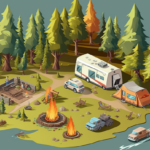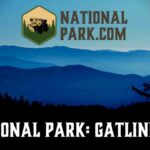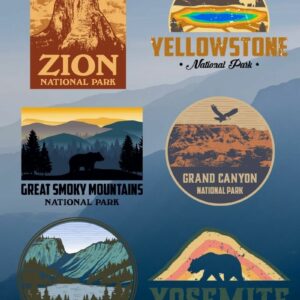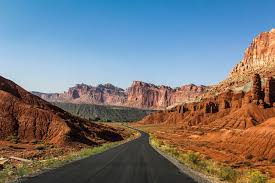Rocky Mountain National Park
Rocky Mountain National Park is full of rich history, beautiful natural wonders, and plenty of activities for visitors to participate in. Bisected by the Continental Divide, this part of the Rockies has ecosystems that boasts over 150 riparian lakes! Not to mention montane and subalpine forests and treeless alpine tundra. This ecosystem has an incredibly vast wildlife ranging from beaver, to elk, to marmot, and even mountain lion!
Here are some of our favorite fun facts about the nation’s tenth national park.
Things To Do
Rocky Mountain National Park has activities for everyone
Whether you are an avid hiker and outdoorsman, a fisher, a camper, or a lover of wildlife, there is something for you to enjoy at this beautiful park. Here is just a taste of the different activities visitors can partake in.
Hike the scenic Emerald Lake Trail
Beginning at Bear Lake Trailhead, the Emerald Lake Trail is a 3.3 mile trail of moderate difficulty. The trail is rated as moderate difficulty. Many hikers begin their trail at Bear Lake, where they can stop for beautiful views before continuing on to Emerald Lake. The trail itself is a steady elevation climb, and is mostly paved due to heavy foot traffic.
Part of the trail, while pressing back into Tyndall Gorge, follows along Dream Lake, providing spectacular views. The next section of the trail takes you through a beautiful pine forest, before reaching Emerald Lake itself. The trail is used mainly for hiking, fly fishing, and snowshoeing. The best time to visit this trail is June through October.
Visit Sky Pond via Glacier Gorge Trail
For a slightly more difficult hike, visitors can make their way to Sky Pond on the Glacier Gorge Trail. This 8.5 mile trail is heavily trafficked and rated as difficult. While the ultimate destination of this hike is Sky Lake, you can actually come across multiple lakes on the way.
One of the most notable is Loch Vale, a subalpine lake located nearly three miles into the hike. From this point, you will also see Taylor Peak and Taylor Glacier. As you travel along, you will also come to the base of Timberline Falls. Next, you’ll come to the Lake of Glass, an incredible alpine lake that is well worth the climb it takes to get there. A little further and you will come to your final destination of Sky Pond!
The trail is primarily used for hiking, nature trips, and snowshoeing. It is best visited from June through October.
Old Fall River Road
Old Fall River Road was opened in 1920, and was the first auto route in the park that gave visitors access to the higher elevation parts of the park. The road is dubbed a “motor nature trail”, allowing visitors to take in the natural splendor of the park from the comfort of their cars. The road leads visitors from Horseshoe Park to Fall River pass.
The Road follows a path traveled by Indian hunters, who were the first inhabitants and visitors of the park. In this way, it allows visitors to walk the footsteps of the people who came before them.
Some of the sights that you will see in route during this drive include the alluvial fan scoured our by the 1982 Lake Flood, Willow Park (which is a popular sighting destination for elk), the alpine tundra, and the Fall River Cirque, which is an amphitheatre-like formation created by glaciers long ago. Finally, you can wind along Old Fall River Road for a close up look at the nature of Rocky Mountain National Park.
Wildlife Watching
Rocky Mountain National Park is a very popular wildlife watching destination. One of the largest draws for this watching is the elk herd that makes its home in the park. The herd numbers anywhere from 600 to 800 individuals depending on the time of year, and they are a huge draw for any avid wildlife watchers.
Elk viewing can happen at any time of year, but the most popular time is during the fall rut. They often congregate in meadows and near forests. They stay at or above treeline during the summer, and migrate to lower elevations during the fall, winter, and spring. They feed mainly at dusk and dawn.
The park is also home to other popular animals that people come from far and wide to see. Two of these animals are marmots and pikas. Marmots can be spotted on the alpine tundra, mainly along Trail Ridge and Old Fall River roads. Pikas can mainly be seen in rock piles.
They have small barks that they can be located by. There are also opportunities for bird watchers in the park! One of the most exciting sights is the white-tailed ptarmigans. They are common in the area, but they are a rare sight to see. They can be found along the tundra, where they can rely on their natural camouflage to prevent them from being seen. They may be difficult to spot, but the sight is worth the effort!
Camp at Aspenglen Campground
Aspenglen Campground is located near the Fall River Entrance to the park. The campground is a beautiful area, surrounded by a wide variety of different trees, including douglas fir, ponderosa pine, lodgepole pine, and engelmann spruce. There are open meadows ensconcing the campground, which bloom with grasses, shrubs, and beautiful seasonal wildflowers. There are a variety of options for camping, including tent and RV camping. There are also walk to tent sites, which offer a more secluded camping experience.
Fishing
Fishing is another popular reason to visit the park! Rocky Mountain National Park contains over fifty lakes and countless streams that provide fishing opportunities. Sport fishing is allowed within the park borders, although you must have a Colorado fishing license, and some special regulations are put into place. To prevent overfishing or disruption of the environments, fishing is balanced with restoration efforts to encourage natural aquatic environments and the creatures that live in the rivers and lakes.
Horseback Riding
Horseback riding opportunities are another way to experience the beauty of the park while also enjoying a completely unique experience. There are two stables located in the park. These are Glacier Creek Stables and Moraine Park Stables. If neither of these stables are available or suit your needs, there are also stables located outside the park that bring riders into the park bounds. Horse Riding in the park is a unique and fun way to experience the park!

Wildlife
Rocky Mountain National Park is home to 280 species of birds, 7 native species of fish, 66 native species of mammals, and 142 species of butterflies
The rich range of habitats and protections in the area allows the local wildlife to thrive within the park. Here are a few of the animals that call the park home.
Beaver
The beaver is the largest rodent in North America, with adults weighing anywhere from 24 to 71 lbs., usually weighing approximately 44 lbs on average. The beaver is a semi-aquatic animal, with many traits that are adapted to this type of life. Some of these include a large, flat tail and webbed back feet. They have unwebbed front feet, which have claws and are used for defense and digging.
They also have a thick layer of fat which keeps them warm in cold water. Their fur is made of long outer hairs and short, fine inner hairs known as a double coat. This fur can be in a variety of colors, usually dark brown or other shades of brown. They are well known for their large front teeth, which grow endlessly throughout their life.
They are mainly active at night. They are very strong swimmers, and can stay underwater for up to 15 minutes at a time. They try to remain in the water when they can, as they are more vulnerable to predators on land. Communication is highly developed in beavers. This communication includes scent marking, vocalization, and tail slapping.
They are known for their building of dams, which go across streams, which they use to create artificial ponds to build their homes, or lodges, in. Their lodges are made of sticks, rocks, and mud, and are usually surrounded by water. They do touch land often, and the beavers dig burrows into the riverbanks.
Beavers are monogamous and mate for life. They form family colonies that all live together. Beaver kits are born with a developed coat, and remain with their parents for up to two years. Beavers are herbivorous, and have distinct foraging preferences.
They eat a mixture of herbaceous and woody plants. Beavers have a few natural predators, including coyotes, mountain lions, and wolves. Sometimes American black bears can prey on beavers as well, which they do by attacking their lodges directly.
Beavers were trapped out in North America, due to the high demand of its fur. The fur was used to make clothes and beaver hats. Extensive trappin began in the early 17th century. During this time, over 10,000 beavers were trapped per year, which severely depleted the population.
Protections for the species began in the late 19th century and continued into the early 20th century. Now, the beaver population is estimated at 10 to 15 million individuals. While this is an improvement, this is a fraction of the population before the fur trade, which was estimated at 100 to 200 million. The beaver is a keystone species, and they increase biodiversity in their territory through creation of ponds and wetlands.
Elk
Elk are some of the most breathtaking and highly photographed animals in the park. This is mainly due to their antlers. Only male elk have antlers. They grow in the spring, and the elk shed them in the winter. Antlers can be up to nearly four feet long, and weigh nearly 40lbs. They can grow nearly an inch a day during the growing season. While they grow, they are covered with a layer of soft skin known as velvet.
Elk are known as ungulates, which means that they have an even number of toes on each foot. Other members of this order are camels and goats. They have a four chambered stomach, and are herbivores. Their main food sources include grasses, plants, leaves, and bark. Grass is their main food source near round, with bark supplementing in the winter when grasses are more scarce. They eat at a very high rate during the summer, and can eat up to 15 pounds of vegetation in a day. They are primarily grazers. They eat mainly in the mornings and evenings, and digest during the day.
Elk are not solitary animals, and they live in single-sex groups during most of the year. This changes during the mating period, when males compete for female attention and create harems, that they then defend from rival males.
Elk follow a migration pattern during the year. They move to higher altitude areas during the spring, and lower areas during the fall. During the winter, elk seek out areas with trees and shelter, both for protection from the elements and bark availability.
They are highly adaptable in their environment. They prefer forest habitats, or close to forests, and mountainous regions. They can also inhabit desert-like areas. They have few predators, the main ones being wolf and coyote packs.
Yellow-bellied Marmot
Yellow bellied marmots are rodents, and usually weigh between 3lbs. To 11lbs. As adults. They measure anywhere between 18 and 27 inches in length, and also have a short tail which measures between 5 and 8 inches.
They have a broad, flat skull, a dark colored head, adn a dark nose, with a white patch. They have a brown coat, with a white patch of fur on the snout. They also have bright yellow fur on their belly, sides of their necks, and throat, which is where the name comes from. They have small, round ears. They have a reddish brown back and yellow feet.
These animals live in southwestern Canada and the western United States. This includes the Rocky Mountains and the Sierra Nevada range. They usually live in valleys, meadows, and foothills, or other open areas that are free of vegetation. They dig their burrows under rocks, which keeps them hidden from predators.
The main predators of the marmots are foxes, coyotes, dogs, eagles, and wolves. They spend approximately 80% of their lives in their burrows, 60% of which are spent hibernating. They are less active during nighttime. They are omnivores, but their diet is mainly made up of plants. These plants include grasses, grains, legumes, flowers, bird eggs, adn insects. When they mate, they have a harem polygynous system, which means that the male reproduces with two or three females at once.
Pika
The American pika was also known as “little Chief hares” in the 19th century. They have a small, round body, which ranges in length from 6 to 9 inches. They usually weigh approximately 6 ounces. They have moderately large ears, which are hairy on both sides, and dark with white margins.
They have a “buried: tail, which is longer relative to their body size. Their fur color varies by subspecies, and can range from grey to cinnamon brown. During the summer, they have more tawny hues, and during the winter it becomes longer and more grey.
The pika is found throughout the mountains of North America, in the western region. They live in talus fields that have suitable vegetation, in alpine areas. They live in piles of broken rock, adn have been known to live in man-made locations like piles of scrap lumber. The pika is a herbivore, and mainly lives on green plants.
These include grasses, thistles, and fireweed. They are highly territorial and defend their territories aggressively. Actual encounters are rare, adn usually occur among pikas unfamiliar with one another. Adult pikas of the opposite sex who occupy territories adjacent form mated pairs, unless more than one male is available, in which case the female chooses her mate. They are very vocal, and use calls and songs to communicate. Songs are used during mating season, and a call is used for predators. Predators of the pika include hawks, coyotes, bobcats, foxes, and weasels.
Mountain Lion
Rocky Mountain National Park is home to a small mountain lion population. Mountain lions are also known as cougars and pumas. These essential predators are solitary and shy, and avoid park visitors when at all possible. Ranging in size from 7-8 feet, mountain lions are the second heaviest large cats, closely following the jaguar. Mountain lions are slender and agile, making them ideal ambush predators. Mountain lions hunt nocturnally for smaller mammals.
As ambush predators, they use stealth to trap and hunt their prey. Mountain lions have the largest range of any land mammal, spanning from the Yukon to the Southern Andes. This large range is made possible by their extreme adaptability, allowing them to adjust to virtually any environment.
Mountain lions face threats from habitat fragmentation and loss, and loss of prey due to poaching. It is unlikely that park visitors will encounter a mountain lion, but if you do, there are precautions you can take. Do not run, shout in a low voice and make yourself look larger, and maintain eye contact.
White-tailed Ptarmigan
One of the most sought after birds for avid bird watchers visiting the park is the white-tailed ptarmigan, or the snow quail. The snow quail is the smallest member of the grouse family. They are stocky birds, and have a square tail and rounded wings. Their beaks are black and they have white feathered legs.
Adults usually measure between 11 and 12 inches long, and weigh from 11 to 17 ounces on average. Their coloring changes depending on the season. In the summer, they are grey-brown, with only their underbelly being white. In the winter, they lose their brown summer feathers and become completely white, to enable camouflage.
These birds live in alpine areas, in high mountains at or above the timberline. They prefer open country, which allows them to travel by their preferred method of running, although they do have the ability to fly. They are the only birds in North America to be permanent residents of the alpine zone.
They tend to live in areas with boulders, snowfields, and upland herbage. They are herbivorous, and their diet varies depending on the season and what food is available. During the spring, they eat snow buttercups, and prefer mountain avens, chickweed blooms, and other flowers and leaves during the summer. In the winter and fall seasons, they subsist mostly on pine needles, seeds, and alder buds. Snow quail are monogamous, and stay with a single partner during the breeding season.
American Dipper
The American dipper is another unique bird that you can find within the park. They live exclusively in riparian habitats, and have unique adaptations that help it suit its environment.
They have an extra eyelid, known as a “nictitating membrane” that allows them to see underwater. They also have scales that close off their nostrils when they are underwater. The American dipper produces more oil than other bird species, which is thought to help them insulate their bodies when they submerge.
They are very vocal birds, with a song that consists of mainly high whistles or trills. They sing year round.
The American dipper is known as a permanent resident, meaning that they stay in their habitats year round. They may move slightly, depending on food availability in different seasons, but not a significant distance.
They have a linear territory along streambanks, which they defend. They are an indicator species, meaning that their presence is indicative of good water quality. Their diet consists mainly of aquatic insects, which can include dragonflies and small crayfish. They have also been known to eat small fish or, on occasion, large fish like the dolly varden trout.

Plant Life
Rocky Mountain National Park is home to a wide variety of alpine and subalpine plant species.
These include a wide variety of trees, shrubs, lichen, and beautiful wildflowers. Here are a few of the different types of plants that one might spot on a visit to the park.
Quaking Aspen
The quaking aspen is a beautiful tree that can be found in the bounds of the park. They can grow up to 65 feet tall, and have smooth, greenish white bark, that often have black spots and lines. They have small, dense leaves with slender branches. The quaking aspens provide beautiful color to the park in the fall seasons. During the fall season, from September to October, the green of the leaves change into beautiful yellow, orange, and red colors.
They grow in montane to subalpine areas, in both dry and moist climates. Aspens are the most widely distributed trees in North America. They are strong enough to survive a harsh mountain environment, one of the few deciduous trees to be able to do so. They are short lived, usually living around 120 years.
They provide a variety of ecosystem services in their environments. These include soil improvement, wildlife habitat, landscape diversity, watershed protection, and others. Species richness in aspen forests is higher than in many other types of forests.
Rather than producing through seeds in these mountain environments, aspens produce “suckers” from lateral roots. These suckers can grow into full grown trees, which creates a system of interconnected roots. These systems have been known to exchange resources between trees.
Narrowleaf Cottonwood
A second tree found in the park is the narrowleaf cottonwood. These beautiful trees can grow to be up to 50 feet, and have slender, tapered leaves. These leaves are a light green color in the summer, and yellow in the fall season. They are dioecious, meaning that trees are either male or female.
They live in altitudes between 7000 and 9500 feet, usually in bare gravel and sand bars, adjacent to streams. These are mountainous trees. They are a staple component of trout habitat along streams. They are also a part of the diet of a beaver. Beavers eat the bark of the younger trees, and use the more mature trees as building materials. They were used by Native Americans to make baskets, specifically young shoots.
Limber Pine
The limber pine is a small tree, usually growing up to 30 feet tall at the most. The diameter of the tree is up to 18 inches. They have broad, symmetrical crowns, and are often flat at the top. They have multiple trunks. The bark of older trees is usually grey and thick, and smoother on the younger branches of the tree.
These pines have needles, which are grouped into bundles of four or give and are one to two inches long. They grow at altitudes of 7000 to 11000 feet, and cling to rocky outcrops in windy areas. They prefer and thrive in windy locations and higher elevations. This allows them to fill niches where other trees will not grow.
These trees have unique shapes, as the powerful wind of their habitats twists them into different shapes. They have very flexible branches, allowing them to handle the wind. They are anchored to the cliffs by a long taproot.
These trees provide important food to wildlife. Porcupines feed on bark, and the seeds of the cones are important food sources for birds and squirrels. They have a particularly mutualistic beneficial relationship with the Clark’s nutcrackers.
During the winter, the lodgepole pine’s seeds are a primary food source for this bird in the winter, and they collect them in the ground. When they do not eat all of the seeds, the uneaten ones can sprout into new lodgepole pines.
Golden Banner
The golden banner is one of the many beautiful wildflowers that bloom in the park. They are a member of the pea family, and live in montane and subalpine meadows and close to streams. They bloom from late May to mid-July, and the flowers are bright yellow. They have five petals, and in late June, pea pods form from each flower.
Cheat Grass
Cheat grass is one of the most prominent invasive species in the park. This grass was introduced from Europe, and made its way into the Rocky Mountain ecosystem. These plants are harmful to native ecosystems. Their seeds drop before native plants have the chance to do so, taking up resources and space.
They are highly flammable, and since they drop their seeds early in the season, they become fire fuel during the hot times in the slate summer. They cause fires to burn faster and hotter, and disrupt the natural fire system.
Wild Rose
The wild rose is a beautiful shrub that grows in montane and subalpine forests, in dry to moist environments. They have light pink flowers that bloom in the early summer, and have bright red rose hips in the fall. They can range in height anywhere from 1 to 4 feet tall, and are dependent on the soil and amount of sunlight they receive.
They have compound leaves, and they range in color from different shades of green. During the fall, their leaves become orange and red. This plant is covered in small thorns. The rose hips produced by this shrub bloom throughout the winter, and are a reliable food source for many animals during this lean time.

Park History
Rocky Mountain National Park has a rich history, spanning from the first inhabitants of the park all the way to the most recent changes to park management.
Here is a brief overview of the main points of history of the park.
The First Inhabitants
Humans first began venturing into the valleys and mountains of the park area approximately 11,000 years ago. There is a little known about the people who first came into the area, mostly in the form of spearheads and scrapers along a nomad’s trail. The Ute tribe favored the valleys, meadows, adn lakes of the area, even though they did not live there year round. They were the main inhabitants until the late 1700’s.
The 1800s
The U.S. government acquired the land that now makes up the park in the 1803 Louisiana Purchase. The area was mostly avoided by settlers and explorers for years. Fur trappers would come into the outskirts of the area in search of fur, and some Spanish explorers did the same. The first account of the Rockies was named Scenes in the Rocky Mountains, written by Rufus Sage in 1843. The Gold Rush of 1859 drew more hopefuls to the area, mostly miners and speculators, who created settlements like LuLu City, which is located in the northwest area of the park. This period led to a homesteading period in the 1860’s. The harsh winters proved to be an obstacle for these settlers, but many braved them all the same.
Creation of the Park
In 1909, Enos Mills, a prominent naturalist and lodge owner, became an outspoken advocate for the creation of the Rocky Mountain National Park, which would become the nation’s tenth national park. He spent several years in this advocacy, lecturing across teh nation, writing letters, and lobbying Congress. He found support in many civic leaders an din the Denver Chamber of Commerce and the Colorado Mountain Club. These efforts were opposed by mining, logging, and agricultural industries. However, Mills was triumphant in the end, and President Woodrow Wilson signed the Rocky Mountain National Park Act on January 26, 1915.
Park Management
After the park was formed, management needed changing. In the early 1960s and 1970s, national environmental laws changed the way the National PArk Service managed their land. Before these laws, there were issues with land management. Driving off road and hiking harmed wildflowers and other vegetation. Elk had no predators, and their populations grew too dense. There were unmanaged wildfires that damaged the forest.
The solution was to manage crowds in the park through campsites and shuttle buses. They had park rangers educate visitors on taking care of the parks, and encouraged research into the subject.

Formation of the Park
The formation of Rocky Mountain National Park is a story of erosion and uplift, beginning nearly 60,000,000 years ago.
Here are the highlights of the geological history of the park.
The Beginning
The Rocky Mountain Range began to form approximately 60,000,000 years ago. This was at the end of the Age of Reptiles. Some scientists speculate that the changes in climate and vegetation caused by the uplift of the range may have contributed to the decline of the dinosaurs and the development of mammals. The initial uplift of the area was slow. It was in the form of a great fold, which involved thousands of feet of sedimentary beds deposited by the seas that covered the region.
Erosion and Uplift
The next part of the story involves erosion and even more uplift. During this period, approximately 10,00 feet, or almost two miles of sedimentary rock were washed away from the top of the fold. This uncovered the ancient schists and granites that formed the core of the fold, which were carved out by mountain streams after uncovering. The erosion resulted in a rolling plain of moderate elevation, surrounded by low, rounded mountains. The rock that was washed away was deposited as a blanket of sand and clay, which now forms part of the Great Plains.
Intermittent Uplift
After the initial formation, uplift continued to happen at intermittent intervals. First, the area of the upper Flattop was raised about 500 feet which enabled the streams of the area to begin erosion and destruction of the Upper Flattop surface. The streams deepened and widened the valley, aided by continued uplift.
This cycle of erosion and uplift has continued throughout the millions of years since the initial formation. Remnants of erosional surfaces are preserved on the tops of some mountains and plateaus, including Deer Mountain and the Needles. Each of these surfaces marks a pause in the great uplift .
A recent uplift began in the Pliocene and may be continuing today has given the streams the ability to continue deepening the mountain canyons. The mountains are so tall in comparison to the lowlands because their rock is harder, and resistant to erosion. The uplift enabled the stress to wash away the softer rocks of the lowlands, making the height difference even more striking.


















